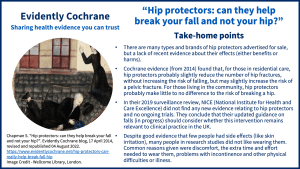A blog about hip protectors for reducing the riskA way of expressing the chance of an event taking place, expressed as the number of events divided by the total number of observations or people. It can be stated as ‘the chance of falling were one in four’ (1/4 = 25%). This measure is good no matter the incidence of events i.e. common or infrequent. of fractures in older people who fall. Is there evidence about the benefits and harms, and do people like them?
Page originally published: 17 April 2014. Revised and republished: 04 August 2022, to include NICE guidance and take-home points.
Take-home points
My Mum was a faller. One of my earliest memories is of walking with her when she suddenly sprawled onto the pavement. I was horrified, but the only injuries were to her tights, her dignity and my belief that she was invulnerable. Years later, a fall headlong into deep sand on a lovely Tuscan beach left her unable to get up until a bemused holidaymaker, gazing after our retreating backs as we trooped ahead with our beach paraphernalia, came to her rescue. The first we knew of it was when she caught us up, covered in sand and helpless with laughter. Her last fall, in her mid-seventies, resulted in a broken hip.
How about wearing hip protectors?
With falls more likely and the chance of injury higher, is it a smart move for older people, especially the frequent fallers like Mum perhaps, to wear hip protectors? These are devices worn over the hips in underwear designed to hold them (or some over clothing), with the aim of lessening the risk of breaking a hip should the wearer fall. They are either soft pads, which absorb the shock on impact, or hard shells, which deflect the force of the impact away from the hip bone to the soft tissue of the thigh.
A quick Internet search brings up plenty of adverts for these. In exchange for about £40-£50 you are offered the pants and pads along with promises of ‘peace of mind’, ‘round-the-clock comfort’ and a ‘clinically proven’ means of protection from a broken hip.
Have we got evidence to support the claims?
The Cochrane ReviewCochrane Reviews are systematic reviews. In systematic reviews we search for and summarize studies that answer a specific research question (e.g. is paracetamol effective and safe for treating back pain?). The studies are identified, assessed, and summarized by using a systematic and predefined approach. They inform recommendations for healthcare and research. Hip protectors for preventing hip fractures in older people looking at the effectivenessThe ability of an intervention (for example a drug, surgery, or exercise) to produce a desired effect, such as reduce symptoms. of hip protectors for preventing hip fractures was first published in 1999 and the evidence looked pretty promising. Subsequent updates with new evidence (most recently March 2014) have shown a less hopeful picture. The review includes evidence from 19 trialsClinical trials are research studies involving people who use healthcare services. They often compare a new or different treatment with the best treatment currently available. This is to test whether the new or different treatment is safe, effective and any better than what is currently used. No matter how promising a new treatment may appear during tests in a laboratory, it must go through clinical trials before its benefits and risks can really be known. with around 17,000 older people, including those living independently and in care facilities and using both hard and soft hip protectors in underwear.
So what did they find?
Protection from breaking a bone?
For those in residential care, hip protectors:
- probably slightly reduce the number of hip fractures. The evidence suggests that for every 1000 people wearing hip protectors 11 fewer will break a hip, but this could range from 20 fewer to none.
- may slightly increase the small risk of a pelvic fracture.
- probably have no effect on other breaks or on the likelihood of falling.
For those living in the community, hip protectors:
- probably make little to no difference to the risk of breaking a hip.
Round-the-clock comfort and peace of mind?
Well this is interesting. There’s reliable evidence that very few people had side effects such as skin irritation. But lots of people didn’t want to wear the hip protectors in the first place and of those who did many did not stick to wearing them. This calls into question how comfortable people found them.
The reviewers note that other research has found that common reasons given for not wearing them include discomfort, the extra time and effort needed to wear them, problems with incontinence and other physical difficulties or illness.
They also cite a studyAn investigation of a healthcare problem. There are different types of studies used to answer research questions, for example randomised controlled trials or observational studies. carried out in Norwegian nursing homes which compared soft and hard protectors and found that people were more likely to continue with soft ones and to wear them day and night. They conclude that there needs to be a better understanding of both personal and design factors that may influence their acceptability and use.
What does the National Institute for Health and Care Excellence (NICE) say?
In their guideline Falls in older people: assessing risk and prevention (published June 2013), NICE included hip protectors in the section “Interventions that cannot be recommended because of insufficient evidence”. This is not because there is strong evidence against them, but because there is insufficient or conflicting evidence supporting them. They recommended that research should be done to investigate the effectiveness of hip protectors compared with other fracture prevention interventions in older people at high risk of falling.
In their latest surveillance review (2019), done to inform the update of their guideline (expected June 2024) they did not find any new evidence relating to hip protectors, and no ongoing trials. They conclude that the update should consider whether this interventionA treatment, procedure or programme of health care that has the potential to change the course of events of a healthcare condition. Examples include a drug, surgery, exercise or counselling. remains relevant to clinical practice in the UK.
Preventing falls
Of course, we know that prevention is better than cure and it’s best not to fall at all, to which end we have some pretty good evidence about things that older people can do to reduce their risk of falling. You can read about that in this Special Collection on Preventing falls and fall-related injuries in older people.
The most recent (2021) trial evidence on falls prevention interventions (though not including hip protectors) from the UK’s NIHR Health Technology Assessment concludes that exercise is the most effective way of preventing falls in people aged 70 and over.
Join in the conversation on Twitter with @CochraneUK @SarahChapman30 or leave a comment on the blog.
Please note, we cannot give specific medical advice and do not publish comments that link to individual pages requesting donations or to commercial sites, or appear to endorse commercial products. We welcome diverse views and encourage discussion but we ask that comments are respectful and reserve the right to not publish any we consider offensive. Cochrane UK does not fact-check – or endorse – readers’ comments, including any treatments mentioned.
Sarah Chapman has nothing to disclose.
Featured image: Credit – Wellcome Library, London. Detail from A man falling over on a cobbled street in Rome, his wife praying to Sansovino’s Virgin and Child, 27 May 1851. Mixed media.




I have had two non-displaced fractures of ramus bones resulting from falls in the past four years. The most recent occurred when I was walking with poles on icy ground. I am a very fit 80 year old who would like to continue walking in the Canadian winter.
Can they cause water infections?
The only mention of infection in the Cochrane review is that in one of the included trials 5% of people wearing hip protectors reported minor skin irritation or infection.
My 99 yr old mum has been asked to wear hip protectors by the care facility she is in. Is there any solid evidence that hip protectors are effective or reduce the impact of falls?
The Cochrane evidence says that, for those in residential care, hip protectors:
– probably slightly reduce the number of hip fractures. The evidence suggests that for every 1000 people wearing hip protectors 11 fewer will break a hip, but this could range from 20 fewer to none.
– may slightly increase the small risk of a pelvic fracture.
– probably have no effect on other breaks or on the likelihood of falling.
There’s reliable evidence that very few people had side effects such as skin irritation. But lots of people didn’t want to wear the hip protectors in the first place and, of those who did, many did not stick to wearing them. This calls into question how comfortable people found them.